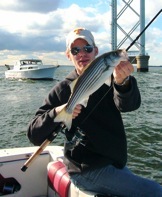 Following up the previous article on basic vertical jigging techniques, I want to share what I know for kicking it into the next gear. Most of these methods are a natural progression from vertical jigging. Jigging is an extremely productive method for catching Chesapeake Bay rockfish, so it’s something you’ll want to practice and learn well.
Following up the previous article on basic vertical jigging techniques, I want to share what I know for kicking it into the next gear. Most of these methods are a natural progression from vertical jigging. Jigging is an extremely productive method for catching Chesapeake Bay rockfish, so it’s something you’ll want to practice and learn well.
Most of my techniques have been honed over time by bass & striper fishing in fresh water situations. Bay fishing is similar in many respects, but there some special considerations.
The Chesapeake Bay is very shallow compared to many striped bass environments. While suspended fish are occasionally encountered, it’s more likely that they are either feeding on the surface or holding near the bottom.
Ledges, humps, and structure
To begin I’ll discuss techniques used on the drift. The equipment and bait is the same as discussed in the basic techniques article. After you’ve marked fish on the finder and positioned the boat to drift over them you’ll likely find hotspots where strikes are more likely. Depending on the wind and current you may only be over the fish for a few seconds. The next obvious step is to cast toward the area where you are getting the most strikes.
As in vertical jigging, it’s still very important that your lure is heavy enough so you can feel the bottom. The only exception to this rule is when fishing bridge pilings or in other rare situations when fish are suspended. I’ll touch on that in a later paragraph.
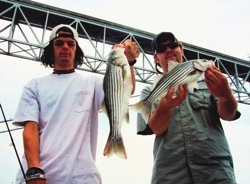 This method works for fishing soft plastics or metal jigs. Before casting, compensate for the current and boat drift. Always cast across and slightly up-current allowing the lure to drift down into the fish. A lure being jigged against the current looks less natural. No matter how far you cast, the lure is going to immediately start sinking at an angle back toward you. A jig moving at an angle through the water can induce strikes when vertical jigging fails.
This method works for fishing soft plastics or metal jigs. Before casting, compensate for the current and boat drift. Always cast across and slightly up-current allowing the lure to drift down into the fish. A lure being jigged against the current looks less natural. No matter how far you cast, the lure is going to immediately start sinking at an angle back toward you. A jig moving at an angle through the water can induce strikes when vertical jigging fails.
It’s important to note how the wind is blowing. If it’s blowing in the same direction of the current, you’ll drift very fast so you need to cast farther. When the wind is against the current, it might be possible to keep the boat stationary over your fishing spot a lot longer. Sometimes the wind is stronger than the current so you’ll actually drift upstream. It’s still important that the lure moves in the direction of the current. That’s the way the fish will expect the baitfish to arrive. It’s not windy below the surface!
Leave the spool open so that the bait falls as fast as possible. I’ll sometimes even raise my rod tip quickly so that more line comes off the spool. The object is to get to the bottom fast. As soon as you feel the lure contact the bottom, jerk back toward you. This doesn’t have to be an exaggerated motion. Sometimes just a quick little snap is all that’s necessary. Fish prefer different presentations at different times, so some experimentation is helpful. As the lure sinks back, point your rod tip directly toward it and keep your line tight. This is when you’re most likely to get strikes so be ready. Once you feel the bottom, quickly repeat the motion. Don’t let the lure stay on the bottom long. A split second is all that’s needed. A lure that drags across the bottom can cause the fish to lose interest and will often snag.
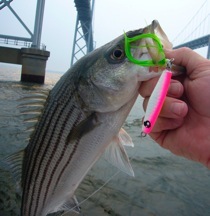 Sometimes I might vary the twitches so that I follow a slight twitch with a stronger one, or I might alternate the direction of the way the tip of my rod moves up as I jerk. In high current, I pull the lure up farther off the bottom. Unless fish are suspended, it’s very important that the lure always bounces along the bottom and that your line remains tight. Unless you’re drifting very fast, you’ll need to reel in line. The best time to do this is when the lure is falling. When the lure gets too close to the boat to feel the bottom, reel it in and make another cast.
Sometimes I might vary the twitches so that I follow a slight twitch with a stronger one, or I might alternate the direction of the way the tip of my rod moves up as I jerk. In high current, I pull the lure up farther off the bottom. Unless fish are suspended, it’s very important that the lure always bounces along the bottom and that your line remains tight. Unless you’re drifting very fast, you’ll need to reel in line. The best time to do this is when the lure is falling. When the lure gets too close to the boat to feel the bottom, reel it in and make another cast.
There are times where I’ve found it necessary to fine tune the angle of retrieve in order to get strikes. If fish are apparent on the finder, and you aren’t getting strikes, experiment with different retrieves, different weights, and different angles. You might find one that works.
Bridge Pilings
Bridge pilings provide some of the best light tackle fishing on the Chesapeake Bay. Fish often suspend around the concrete columns waiting to ambush bait. Since the water must flow around the pilings it creates a lot of current. Most fishermen like to fish directly behind the piling. The traditional theory is that rockfish are more likely to hold in the area that has the least current. That may be true, but fish holding in those areas aren’t always actively feeding. You’ll catch a lot more fish if you cast to the up-current side and let the lure drift as close as possible to the piling.
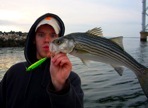 One of the more difficult skills for fishing pilings is positioning the boat. In high current situations it can be difficult to fish alone. You’ll often need a partner to hold the boat steady and keep it from crashing into the concrete. A big positive is that you can sometimes keep the engine running around pilings. Sound is transferred into the water from traffic on the bridge, so the fish are less likely to notice engine noise. Nevertheless, I kill the engine whenever possible. Bigger fish are smarter, and they know what a boat motor sounds like.
One of the more difficult skills for fishing pilings is positioning the boat. In high current situations it can be difficult to fish alone. You’ll often need a partner to hold the boat steady and keep it from crashing into the concrete. A big positive is that you can sometimes keep the engine running around pilings. Sound is transferred into the water from traffic on the bridge, so the fish are less likely to notice engine noise. Nevertheless, I kill the engine whenever possible. Bigger fish are smarter, and they know what a boat motor sounds like.
Move the boat so that you can cast up into the current in front of the piling. If the current is very strong, you may need to cast several yards upstream. Remember that your lure sinks at an angle depending on the current and always back toward your rod tip. If the fish are deep, it’ll take it a while to sweep into the strike zone. Keep the line tight as it sinks and be alert for strikes. Be wary of underwater supports, cables, and other debris around bridges.
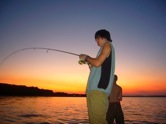 I’ve found soft plastics more productive than metal jigs when fishing pilings. I start with chartreuse then move to blue or purple. I’ve also found that a lighter jig head is more effective. While heavier jigs stay closer to the piling, a lighter one “swims” around the concrete and looks more natural. Nevertheless, the jig should be heavy enough to fall to the depth where the fish are feeding. Experimentation is always necessary. Depending on changing conditions, some pilings are more productive than others. After the cast I lower the rod tip and quickly snap the jig back to the boat while reeling. After two or three casts with no strikes, I move on. If I find a piling holding fish, I stay with it because they often swim on and off while feeding. There’s more information about fishing pilings in my Bay Bridge chapter.
I’ve found soft plastics more productive than metal jigs when fishing pilings. I start with chartreuse then move to blue or purple. I’ve also found that a lighter jig head is more effective. While heavier jigs stay closer to the piling, a lighter one “swims” around the concrete and looks more natural. Nevertheless, the jig should be heavy enough to fall to the depth where the fish are feeding. Experimentation is always necessary. Depending on changing conditions, some pilings are more productive than others. After the cast I lower the rod tip and quickly snap the jig back to the boat while reeling. After two or three casts with no strikes, I move on. If I find a piling holding fish, I stay with it because they often swim on and off while feeding. There’s more information about fishing pilings in my Bay Bridge chapter.
Hot Rod Jigs
Fishermen are known for constantly tinkering with lures in an effort to make them catch more fish. I’m no exception. I especially like to improve the look of my soft plastic baits with scents and dyes. One of my favorite techniques is dipping the tails of my lures in Spike-It which is specially made for the purpose. It also comes in a spray can, or in a pin type device. I’ve experimented with several scents and colors. My current favorites are garlic scents with orange, chartreuse, blue, or red dye. Sometimes I combine the colors to create a more dramatic contrast. I learned this technique from my dad who was known as one of the best largemouth bass fishermen in the southeast. He made most of the plastic worms he used for bass fishing and frequently alternated the colors. He won the Field & Stream big bass contest in 1964 using a worm with contrasting colors. Try hotrodding your jigs once, and you’ll never leave home without the dye again.
Kandy Korn Jig Heads

Since I’m a fan of contrasting colors, I also paint my jig heads with alternating patterns of orange, chartreuse and white. I find this especially effective in the winter and spring when fish need that extra little push to get a reaction strike out of them. The color combination I like the best looks sort of like the sugary snack Candy Corn, especially since I usually pour triangular “shad” style jig heads. I trademarked the term hoping kandy korn jig heads can be made available commercially some day. I’ve noticed some of the better-known jig head makers in the Mid-Atlantic have now started producing similar color combinations.
Teasers
A technique that can be extremely effective when jigging is to attach a teaser which is sometimes called a dropper fly. Sometimes a feather fly or buck-tail tied above a jig will catch fish when the jig won’t. If the fish are biting my usual jigs, I never tie on a teaser. I like to feel the strength and fight of the individual fish, so I’m not out to catch two fish at the same time. On the other hand, there are times when the dropper fly will out-catch the terminal lure. I sometimes use 1/8 to ¼ ounce buck-tails as teasers because I think the additional weight increases the action of the fly, but sometimes, especially when the fish are feeding on silversides or anchovies, an unweighted clouser fly works great. I attach 2 inches of leader using a double loop knot. Teasers work very well for vertical jigging, but they can also be used when casting.
Suspended fish
Occasionally, especially in the spring or fall, I’ll encounter fish that are suspended. They’re usually moving quickly and feeding on baitfish in the mid levels of the water column. This is often in an area where water temperatures chang rapidly resulting in a thermocline or pycnocline as it is more accurately called in the Bay. Mouths of rivers or creeks are the most obvious locations for differing layers of temperature. There may be less oxygen in one layer or the fish might prefer one temperature over another. It’s often the depth of the bait-fish that attracts the stripers. For whatever reason, it’s a challenging situation and very important that you keep your lure in the area holding fish as long as possible.
While metal jigs will work for suspended fish, I don’t use them near as much in the bay as I did in the deep southern lakes. Here, I prefer lures that provide more action because I often don’t jig at all. Soft plastics are my first choice, matching the length of the lure to the approximate size of any bait I might have noticed. I cast as far as I can past the area where the fish are holding and, in depths less than 30 feet, I allow the lure to sink to the bottom. This provides a reference point and fine-tunes my sensitivity down the line. Then, I snap the lure back though the fish using a loose wrist and swift, sharp jerks. Swim-baits like Storm Shads or Sassy Shads also work well for suspended fish. I cast past the area where I think the fish are located, allow the lure to fall to the correct depth, and then swim it back with a moderate retrieve, jerking occasionally. Swim-baits sink slower than other jigs. To determine how to get your lure to the correct depth, practice at the boat ramp before you leave. Get your formula by dropping the lure into the 5’ or so beneath the boat and count to see how long it takes to hit the bottom. Count your turns as you reel back up so you know how much line you take in with each rotation.
Suspended fish are often very finicky, so sometimes swim-baits don’t work. In that case I’ll cast a bass jig with pork rind, a Gotcha Lure or a crank-bait. Gotchas sink very fast and should be jerked erratically similar to the action you’d give a top-water lure. My favorite crank-bait for casting to suspended fish in the Bay is a blue & silver rattle-trap. Unless the fish are deeper than 15’ I throw the floating version because it provides more wobble. I use a very fast retrieve. I sometimes use larger crank-baits as well. The “pig and a jig” method for catching largemouth bass also works for suspended stripers. Especially effective around bridge pilings, try a lightweight chartueuse or white bucktail with a bright porkrind trailer.
Finally, the “do-nothing” method often works for suspended fish. This technique is also surprisingly effective around bridge pilings. Tie on a light jighead and cast out a soft plastic bait to where the fish are feeding. Then, do nothing, just let the lure sink slowly through the fish keeping the rod tip up and the line tight. After the lure falls through the fish, infrequently snap it back toward the boat letting it fall back slowly after each gentle snap. Scents and dyes will increase the number of strikes you get with the do-nothing method. I’ll talk more about it in my Bay Bridge chapter. Check out the video of this method in the Videos section. One more thing, a fisherman using a fly rod with slowly sinking line and a properly weighted fly can be a very effective method when fish are suspended.
Much more can be said about jigging. I’ll write more as I encounter interesting situations. Stay tuned to my fishing reports where I’ll include additional tips and tricks as specific circumstances arise. As with everything, practice makes perfect so the more time you spend on the water the faster you’ll master advanced techniques. With a little practice and patience, the methods I’ve presented will work and result in nice fish. Good luck and good fishing!
Copyright © 2009 Chesapeake Light Tackle.Com All Rights Reserved




Hey shawn,
I am a big fan of your website. Thank you for providing such great info. I just bought some spike it. My question is can I dip my BKD’s at home and put them in a bag or is it better to dip them just before fishing.
Regards,
Bill
Hi Bill —
I was delayed answering your question due to a quirk in the website. I would do it on the water. I think the scent will be stronger that way. Also, that dye runs and gets all over the lures. You can come up with some interesting colors, but it might not be the color you’re looking for. Hold it way out away from the boat though. It get’s all over everything and takes a long time to fade off your gelcoat.
Hi Shawn,
Very cool blog! Getting hyped to try some of your techniques. I currently have 40lb braid on a 6’6″ medium-heavy ugly stick. Any reason to change out and use lighter line? Saw you recommended using 10-20lb braid. Will it affect the sensitivity or something?
Best,
Pete
rodbag2011…
[…]Light Tackle Jigging – Tricks & Tips | Chesapeake Light Tackle[…]…
apartment near ucla house for rent ca…
Light Tackle Jigging – Tricks & Tips | Chesapeake Light Tackle…
apartments in westwood ao…
Light Tackle Jigging – Tricks & Tips | Chesapeake Light Tackle…
emergency handyman san francisco…
Light Tackle Jigging – Tricks & Tips | Chesapeake Light Tackle…
Pandora Bracelets And Charms Catalog
Light Tackle Jigging – Tricks & Tips | Chesapeake Light Tackle
movers becomes
Light Tackle Jigging